The floral smell of jasmine is well-known. There are other varieties, such as delicate plants that will fill your house with the aroma of flowers and fragrant climbers with summer flowers for a protected area.
For its fragrant white or yellow flowers and glossy green leaves, many varieties of jasmine are cultivated. The Jasminum genus has about 200 species of flowering shrubs and vines, both deciduous and evergreen.
The best 18 jasmine plants that will offer your garden a wonderful makeover are covered in this blog. Prepare to be engrossed in the captivating realm of jasmine flowers as you explore the ideal variety to complement your outdoor retreat.
1. Arabian Jasmine
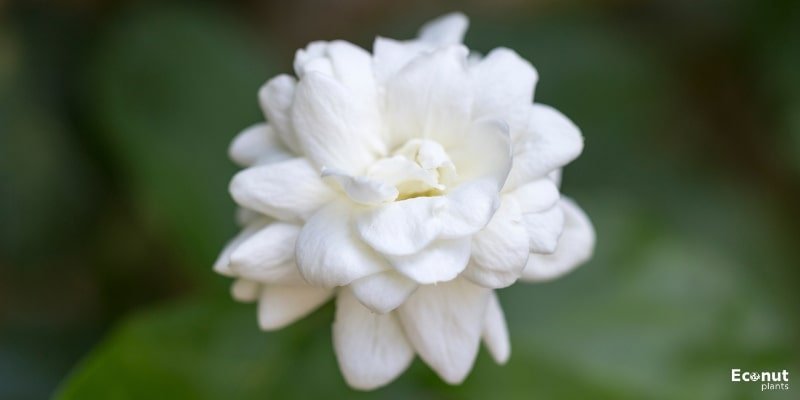
Scientific Name: Jasminum sambac
Plant Type: Evergreen vine
Sun Exposure: Full to partial sun
Plant Size: 2-5 ft
Plant Zone: 8-11
Arabian Jasmine is distinguished by its large, rounded leaves and many-petaled blooms, while other types have equally lovely tiny, delicate petals. Jasmine tea is derived from this flower as well. Most of the time, these white blossoms bloom multiple times a year. Their petals get slightly pink as they become older, instead than remaining pure white.
Although it is a shrub in the main, you can train this plant to become a vine. Determine the purpose of this plant and train it accordingly. The national plant of the Philippines is the Arabian jasmine. Fun fact.
2. Pink Jasmine
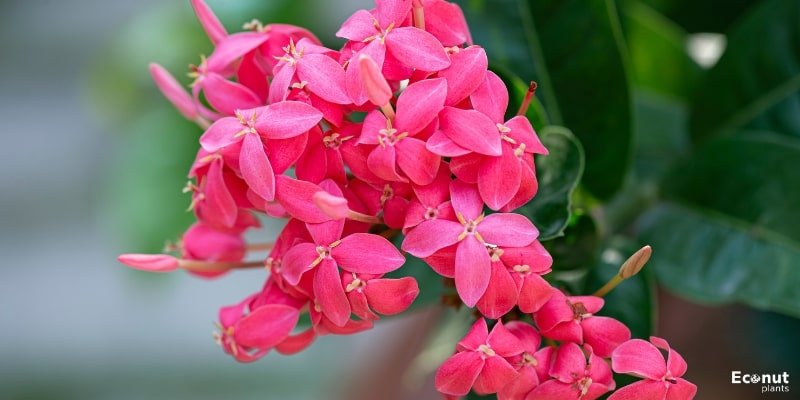
Scientific Name: Jasminum Polyanthum
Plant Type: Evergreen perennial
Sun Exposure: Full or Part shade
Plant Size: 20ft
Plant Zone: 8-11
Pink jasmine is a great option if you want a pop of colour. Its profusion of pink and white flower clusters fill the air with a delightful aroma and produce a breath-taking visual impression. This hardy climber is a versatile addition to your garden, growing well in both full sun and partial shade.
3. Common Jasmine

Scientific Name: Jasminum officinale
Plant Type: Deciduous or semi-evergreen
Sun Exposure: Full or Part shade
Plant Size: 20 to 30 ft.
Plant Zone: 7 to 10
The common jasmine is a huge, graceful-looking, vining shrub that is semi-evergreen or deciduous. It is also known by the names poet’s jasmine and true jasmine. It bears enormous clusters of three to five white flowers in late spring or early summer that continue into October. Common jasmine is occasionally cultivated in pots and taken inside for the winter in northern latitudes.
4. Showy jasmine

Scientific Name: Jasminum floridum
Plant Type: Evergreen shrub
Sun Exposure: Full sun or partial shade
Plant Size: 3-5 ft
Plant Zone: 8–10
The flower of the amazing jasmine plant is a pale yellow colour. It is a shrub that grows quickly and can reach a height of four feet. The blooms are visible in zones seven through nine, and they are most frequently observed in the spring and summer. For the best growth, full sun is ideal.
5. Downey Jasmine

Scientific Name: Jasminum pubescens
Plant Type: Evergreen
Sun Exposure: Full sun to part shade
Plant Size: 8-12 ft
Plant Zone: 9-11
You can train this plant to become either a vine or a shrub. When taught properly, Downey Jasmine may reach fairly high heights. These plants develop quickly. Therefore, bear it in mind if you wish to prevent pruning.
The flowers that cover this shrub gave it its name. The tiny flowers have slender, tapering petals. This plant is really lovely when it is fully blooming. You should be aware, nevertheless, that the perfume produced by this plant is not particularly strong.
6. Star Jasmine

Scientific Name: Jasminum multiflorum
Plant Type: Evergreen
Sun Exposure: Full sun
Plant Size: 10 ft
Plant Zone: 8–10
The expression “white as snow” is widely used, yet in India, the plant known by the Indian name “kunda” is used instead. This specific species is frequently mentioned in Indian mythology. To Vishnu, one of the main gods of Hinduism, it was sacred.
The star jasmine holds great significance for Manipur’s wedding customs. Two Star Jasmine flowers are given to the husband by the bride. One of the flowers is then taken by the groom and returned to the bride.
This variety of jasmine doesn’t smell as strong as other varieties. This is a thirsty species, especially throughout the blooming season. The soil must remain somewhat damp but not drenched.
7. Night-Blooming Jasmine
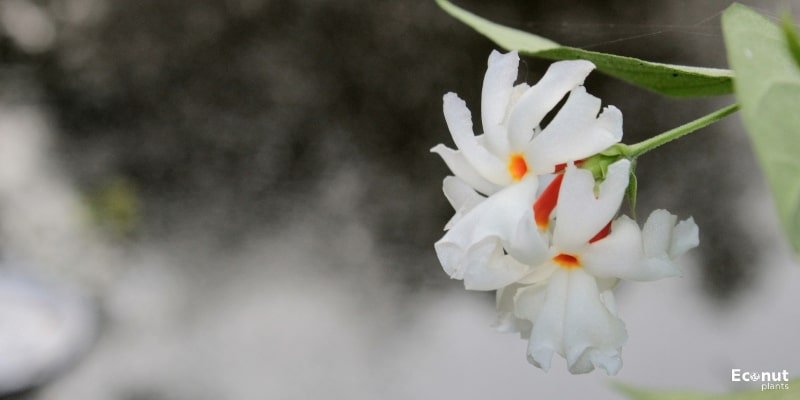
Scientific Name: Cestrum Nocturnum
Plant Type: Evergreen
Sun Exposure: Full sun
Plant Size: 2.5 ft
Plant Zone: 8-11
The jasmine called “Night-Blooming” releases its sweet aroma into the air as it opens its blossoms in the evening, true to its name. Especially in outdoor seating areas where you can take in the entrancing smell on warm summer nights, this shrub-like plant is perfect for creating a romantic ambiance in your yard.
8. Primrose Jasmine
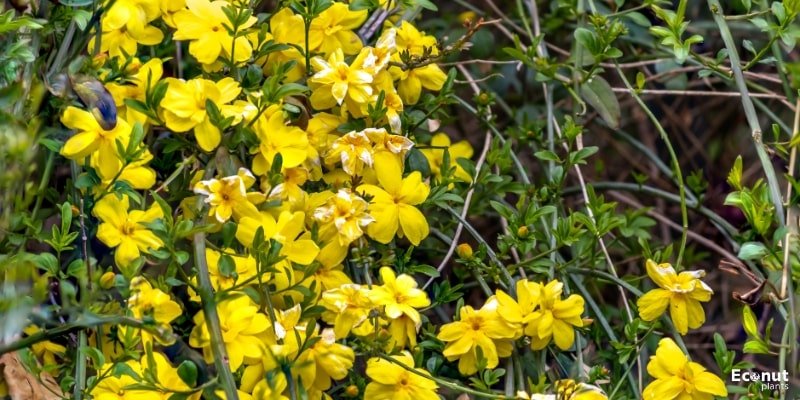
Scientific Name: Jasminum mesnyi
Plant Type: Semi-evergreen or evergreen
Sun Exposure: Full sun to part shade
Plant Size: 6 ft
Plant Zone: 8-10
Primrose jasmine is rather unique in the United States; however, it ought to be planted more frequently. Larger than other jasmine kinds, the shrub yields 1- to 2-inch yellow flowers that bloom in early spring and remain for a few weeks.
This big shrub grows in an open, sprawling manner and can withstand severe droughts pretty well. It is occasionally referred to as Chinese or Japanese jasmine. If this plant is not regularly cut back, it may become unduly brushy.
9. Crape Jasmine
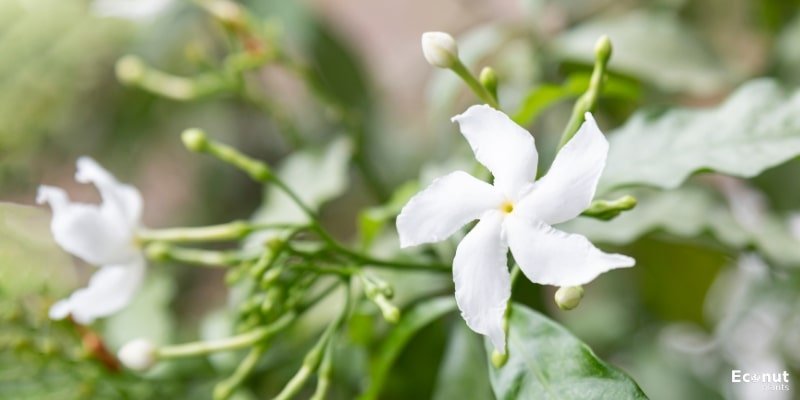
Scientific Name: Tabernaemontana divaricata
Plant Type: Evergreen shrub or small tree
Sun Exposure: Full sun
Plant Size: 8–15 ft
Plant Zone: 9-11
One of the most decorative varieties of jasmine is the rape jasmine. Big, white blooms that are partially or completely doubled are held high above glossy leaves. These plants smell particularly good in the evening and at dusk. Although it may be grown in containers, this fragrant jasmine plant needs regular trimming to keep its desired size and shape.
10. Winter Jasmine

Scientific Name: Jasminum nudiflorum
Plant Type: Deciduous shrub
Sun Exposure: Full sun to partial shade
Plant Size: 4 feet tall
Plant Zone: 6-10
This variety of jasmine is also known as Jasminum nudiflorum. If you want some color in your winter garden, these shrubs are ideal to cultivate. The plant will grow to a height of 4 feet when planted as a shrub.
Winter jasmine grows best in the chilly winter months and in the spring. The shrub can go as high as seven feet and as wide as four feet. This jasmine produces little to no perfume from its yellow blossoms.
11. Dwarf Jasmine

Scientific Name: Jasminum parkeri
Plant Type: Deciduous shrub
Sun Exposure: Full sun
Plant Size: 2.5 feet
Plant Zone: 6-10
This little evergreen shrub bears five-petaled, sunshine-yellow flowers. This variety’s fragrant, decorative flowers are used in topiaries and bouquets. They grow in clusters.
12. Wild Jasmine

Scientific Name: Chrysojasminum fruticans
Plant Type: Evergreen shrub
Sun Exposure: Full sun to part shade
Plant Size: 12 ft
Plant Zone: 7-11
Compared to other types, wild jasmine is far more akin to a shrub. It can be grown as such or used as a groundcover, also thrives on hanging plants and hedges.
It tolerates drought well and thrives in full sun exposure. But even so, if at all possible, you ought to try to water it frequently. In spite of the fact that this variety is more tolerant of cold than others, you should still avoid planting this plant in a cold climate.
If you’re looking for simple yellow flowers and thick, delicate leaves, choose this plant. Selecting a different type can be wise if you’re looking for a fragrant plant. Compared to many other jasmine plants, this one does not have particularly fragrant blossoms.
13. Italian Jasmine

Scientific Name: Jasminum humile
Plant Type: Evergreen shrub
Sun Exposure: Full sun to part shade
Plant Size: 12 ft
Plant Zone: 7-11
In the summer, hummingbirds and bees are drawn to this attractive shrub that blooms. And the blossoms turn into dark-coloured berries in the fall. The best time of year for flowers to bloom is May–June. Of course, if you give this plant regular watering, it will also grow extremely quickly. In five to ten years, it can reach its maximum height.
This shrub is pest-resistant, drought-tolerant, and easy to maintain, much like many other jasmine cultivars. Use our online identification tool if you’re unsure about this species’ look, as it differs slightly from most other jasmine bushes.
14. Stiff Jasmine

Scientific Name: Jasminum volubile
Plant Type: Evergreen
Sun Exposure: Full sun to part shade
Plant Size: 12 ft
The glossy evergreens leaves of the stiff jasmine, also referred to as Australian wax jasmine, are found on a twining or sprawling vine. It can be clipped into a hedge or trained onto a trellis or other structure. There are times when Jasminum simplicifolium subsp. australiense is used to describe this plant.
15. Forest Jasmine

Scientific Name: Jasminium abyssinicum
Plant Type: Evergreen
Sun Exposure: Full sun to part shade
Plant Size: 16-18 ft
Plant Zone: 8-11
This plant has thicker tendrils than certain jasmine cultivars, which are petite and fragile. These vines usually grow toward the sun and can become quite productive. It also features white flowers with hints of pink and strong, glossy, dark foliage.
The forest jasmine does not have a very particular requirement for sunlight intensity. It is also resistant to various kinds of soil. This shrub can be grown in clay-rich or loamy soil. Planting these plants should be done carefully because they grow quickly.
16. Motia Jasmine
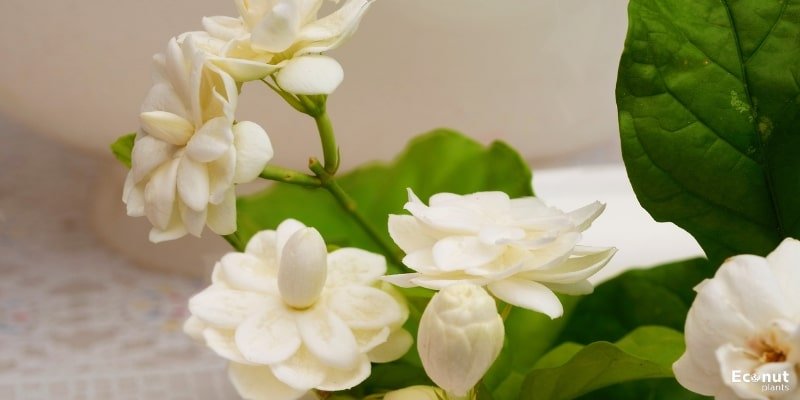
Scientific Name: Jasminum multiflorum
Plant Type: Evergreen
Sun Exposure: Full sun to part shade
Plant Size: 1.6-9.8ft
Plant Zone: 9–11
Motia Jasmine, sometimes referred to as Jasminum polyanthum or Indian Mogra Jasmine, is a very prized type in India. Its little white blooms are numerous and release a heady, alluring scent.
Motia jasmine has cultural importance and is frequently utilised in religious rituals, festivals, and celebrations that are customary in India. Gardeners in India love it for its ageless beauty and captivating aroma.
17. Lemon-Scented Jasmine

Scientific Name: Jasminum azoricum
Plant Type: Evergreen Vine
Sun Exposure: Full to partial sun
Plant Size: 10-12 ft
Plant Zone: 9-11
The pleasant, lemony aroma of these plants truly lives up to their name. These blossoms resemble two flowers stacked on top of one another. The petals have a long, tapering shape. These flowers should be seen in little clusters all over the plant.
Plant this shrub in well-drained soil for optimal results. It thrives in full sun, yet it can tolerate a little shade as well. This species is highly susceptible to cold temperatures. In its natural environment, it is likewise extremely threatened.
18. Royal Jasmine

Scientific Name: Jasminum nobile or Jasminum rex
Plant Type: Evergreen shrub
Sun Exposure: Full or part
Plant Size: 15 ft
Plant Zone: 10-11
If you want a vine that will spread swiftly to take over any space you plant it in, choose this one. It grows very quickly and looks good on topiaries and fences. Of all the jasmine plants, this one is renowned for producing the largest blooms. This cultivar is renowned for having an exquisite smell as well. These flowers don’t smell as intense as some other types, though.
The plant blooms nearly year-round, so you can enjoy whatever aroma there is for a very long time. Unlike other jasmine kinds that do not bloom in the cold, this variety blooms.
Conclusion
You are prepared to select the ideal jasmine varieties for your own garden now that you are aware of their variety. Always be aware of the zone in which you are developing and any other constraints that can influence your choice.
Make sure the kind you choose generates a perfume if you want the jasmine scent. Whichever choice you make, your landscape will look stunning with it.

